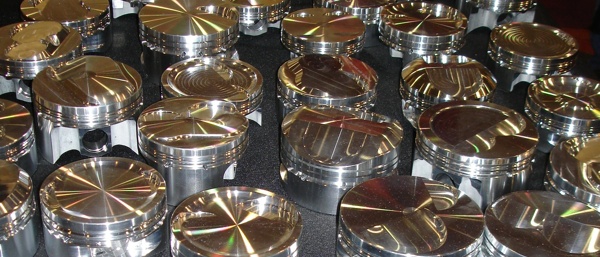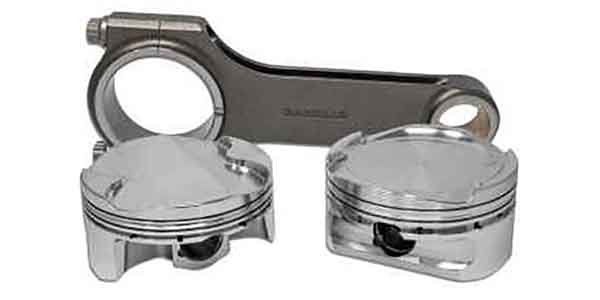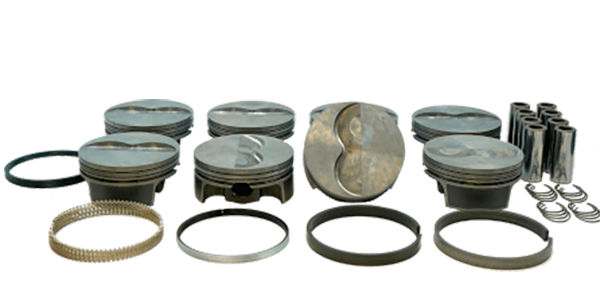 The driving force behind stock and performance piston technology advances has always been the desire to develop lighter, stronger, more durable pistons. Lighter reduces reciprocating mass so the engine can accelerate faster and rev higher with less stress on the connecting rods and crankshaft. Stronger is necessary if you make the pistons lighter so they can withstand the loads that are placed upon them. Durable is a must for pistons that have to last under demanding racing conditions or for tens of thousands of miles on the street.
The driving force behind stock and performance piston technology advances has always been the desire to develop lighter, stronger, more durable pistons. Lighter reduces reciprocating mass so the engine can accelerate faster and rev higher with less stress on the connecting rods and crankshaft. Stronger is necessary if you make the pistons lighter so they can withstand the loads that are placed upon them. Durable is a must for pistons that have to last under demanding racing conditions or for tens of thousands of miles on the street.
In recent years, fuel economy and emission regulations have also been driving piston technology forward. The government has set a Corporate Average Fuel Economy (CAFE) goal of 35.5 miles per gallon (mpg) by 2016, 36.6 mpg by 2017 and 54.5 mpg by 2025. For automakers to reach these goals, the engines in late model cars and light trucks are being downsized and turbocharged. Before long, a 2.0L turbo motor may be the “big” engine option in many passenger cars. Five-cylinder and three-cylinder engines will be replacing many of today’s V6 and four cylinder engines. Ford’s little 1.0L three-cylinder ecoboost engine in the new Fiesta is an example of what’s to come.
As engines get smaller, motorists expect the same performance as a larger V6 or V8 but with the fuel economy of a four cylinder. Turbocharging makes little engines breathe big, but it also increases the load and temperature the pistons have to endure. This, in turn, requires pistons made of alloys that can withstand higher temperatures and combustion pressures. Yesterday’s castings won’t cut it for these kinds of applications.
How GDI Is Changing Piston Designs
The automakers are also switching to Gasoline Direct Injection (GDI) to boost fuel economy and performance. GDI injects gasoline directly into the cylinder rather than the intake port. This requires high-pressure injectors, which also improve fuel atomization for a cleaner burn. Most of these new generation GDI engines utilize special piston configurations with uniquely shaped domes to optimize combustion. Many of these pistons have depressions or bowls in the top similar to a diesel piston to help swirl and direct the fuel charge toward the spark plug as the piston comes up on its compression stroke.
The pistons in GM’s C7 Corvette 6.2L LT1 engine, for example, have a small dome with an offset ramp on one side that induces swirl as the piston moves up during its compression stroke. There is also a recessed cavity or cup in the center of the piston to concentrate the air/fuel mixture right under the spark plug. The cup allows faster combustion and shortens the time any unburned air/fuel mixture in the rest of the cylinder is exposed to high temperatures to minimize the risk of detonation.
The crown configurations on most GDI pistons have been developed to work with the injector spray pattern and timing so these engines can handle extremely lean fuel mixtures (as lean as 40:1 under certain operating conditions) as well as much higher compression ratios (from 11:1 to nearly 14:1 on regular 87 octane pump gas). The U.S. version of Mazda’s Sky Active V6 has a static compression ratio of 13:1 while its Japanese counterpart is 14:1. By comparison, the 6.2L Corvette LT1 has a compression ratio of 11.5 to 1.
Increasing compression improves an engine’s thermal efficiency for more power and better fuel economy, but traditionally has also required higher octane fuel to prevent detonation. Performance engines with 14:1 compression ratios typically require methanol or high octane racing gas with an octane rating of 112 or higher.
So how are they running such high compression ratios without destroying these engines on regular low octane pump gas? The trick is in the injector and valve timing.
Most of these GDI high compression engines also have Variable Valve Timing (VVT). Advancing camshaft and valve timing at low RPM can improve low speed torque while retarding camshaft and valve timing at high RPM can boost high-speed power. On engines with dual overhead cams, changing the timing of the intake and exhaust cams separately can increase or decrease valve duration and overlap, which in turn can change the effective compression ratio of the engine. Retarding cam timing under part-throttle light load can also reduce pumping losses for better fuel economy. In short, there are a lot of cam timing tricks the automakers can program into the PCM to optimize fuel economy, performance and emissions under a wide range of operating conditions.
Variable Valve Timing provides a lot of tuning latitude, but it may also require deeper valve reliefs in the tops of the pistons to provide adequate clearance for the valves. The cam phasers in most engines with VVT can advance or retard the cams 20 to 40 degrees, but some may retard cam timing as much as 60 degrees. That’s a lot of cam rotation, so if the pistons don’t have the proper valve reliefs, things are going to clash if the valves are held open too long (for more on variable valve timing, turn to page 38 of this issue).
GDI engines can also inject the fuel into the cylinder later in the intake stroke, or during the compression stroke to further improve fuel economy – or cut off fuel delivery altogether during deceleration to squeeze every last mile out of each drop of fuel. Deactivating cylinders that are not needed when the engine is lightly loaded is another trick in the toolbox that can make a significant improvement in fuel economy.

Most of these late model GDI engines have a lot of miles to go before our readers will see them in their shops. But performance engine builders are already playing with many of these engines to find ways to make more power.
Replacement pistons for stock GDI engine applications will have to closely follow the OEM design to maintain the same fuel economy and emissions, but for performance applications there are always ways to improve performance. Compression ratios are probably maxed out so there’s probably little room for improvement there. However, changing piston crown configurations to optimize for power rather than fuel economy or emissions is certainly a possibility with many of these motors. Increasing the quantity of fuel that is injected into the cylinder may require enlarging or reshaping the cup area on top of the piston. Likewise, changing the shape of the ramps or bumps on the piston crown may help fuel distribution if the engine is running higher than stock boost pressures or when a power booster such as nitrous oxide is added to the mixture.
The point is piston design today isn’t as simple as it once was. It takes a lot of research and development and computer analysis to come up with an optimum piston design for a GDI engine application. This, in turn, means a growing market for custom piston fabrication.
Custom Pistons
Many aftermarket piston suppliers offer custom pistons in addition to their standard off-the-shelf products. Some piston suppliers say custom pistons account for over half of their sales. These include cast, forged and billet pistons. For forged pistons, 4032 is a popular alloy while 2618 is usually the preferred alloy for higher horsepower blown, turbocharged or nitrous oxide applications. Because 2618 is a stronger, more ductile alloy than 4032, it allows some pistons to be thinner and lighter without sacrificing any durability.
Custom pistons can be designed and manufactured using parameters that have already been developed for other piston designs. You can play around with compression ratios, bore sizes, ring configurations and sizes and wrist pin location. You can increase valve reliefs, add gas ports or change piston heights or skirt lengths.
Thanks to CAD/CAM software for designing pistons, and CNC machine tooling for fabricating pistons, a knowledgeable piston engineer can design a custom piston and test it using finite analysis and other simulation software fairly quickly – in as little as five days with expedited handling according to some piston manufacturers. Of course, a set of custom pistons will cost you more than a set of standard pistons because of the extra development time and handling that is required to produce a set of custom pistons. But for a one-of-a-kind application, custom pistons may be your only option.
Although a wide variety of stock and performance pistons are readily available off-the-shelf for the popular engine and stroker combinations, finding a set of replacement pistons for an odd-ball application or a vintage engine can be a challenge. Fortunately, several aftermarket piston suppliers still make pistons for many vintage applications, ranging from the Olds, Pontiacs, Cadillacs, Fords, Chryslers and Desotos of the 1950s and 1960s all the way back to the early flatheads of yesteryear. Need a set of pistons for an air-cooled Corvair? One piston manufacturer still makes them.
Changing Piston Market
Although pistons for small block and big block Chevy, Ford and Chrysler engines still account for the lion’s share of the aftermarket performance piston business, the mix is constantly changing. The hot applications today are the Chevy LS motors, Ford modular V8s and new Chrysler HEMI – as well as light truck Powerstroke, Duramax and Cummins diesel engines. The demand for popular Chevy small block and big block pistons as well as those for Ford and Chrysler is not going away because these are the affordable engines of choice for many racers and street performance enthusiasts. Even so, as we continue to move forward, the demand for stock and performance pistons to fit many of these newer engines is creating new market opportunities for many piston suppliers. When you look at the new products being introduced by many of these suppliers, they are mostly pistons for the latest generation of engines coming out of Detroit.

Diesel Pistons
Although light truck diesel engines are fairly rugged right from the get go, the availability of aftermarket tuner tools that allow a truck owner to crank up the boost pressure to produce an extra 100 to 200 horsepower means more stress on the pistons – and if the guy is a serious truck puller, the sky (and the demand) is the limit. Some of these engines use multi-stage turbos to produce upwards of 90 lbs. of boost. That’s a lot of horsepower and a lot of stress on the pistons.
Diesel pistons typically have to withstand more heat than gasoline counterparts. Flame temperatures can range from 2600 degrees F to over 3600 degrees F in the piston’s combustion bowl, producing surface temperatures of up to 750 degrees F or higher in the rim area around the bowl. At such temperatures, aluminum pistons can be dangerously close to their melting point so oil cooling is essential to dissipate heat, cool the rings and control thermal expansion.
Diesel pistons are cooled by spraying oil at the underside of the piston and directing some of the oil into hollow cavities or galleries in the top portion of the piston behind the upper ring land. On some pistons, an oil cooling duct or gallery is positioned behind the upper ring groove to help cool the rings.
High operating temperatures also means diesel pistons usually need more clearance to accommodate thermal expansion – especially when an engine is being modified to produce more power. On a stock Duramax, the factory recommends about .002 inch of piston-to-wall clearance. For a street performance/drag application, you might want to allow .006 to .008 inch of piston clearance depending on the type of pistons used (cast or forged) and the amount of boost pressure. For a high boost diesel engine being used in a pulling application, you might need as much as .012 to .013 inch of clearance.
Surprisingly, most production diesel pistons are cast aluminum. The castings are relatively heavy, but strong enough to handle the loads that are typically placed upon them – unless you are talking crazy boost pressures and much higher than stock RPMs. As the boost pressure and engine speed increases, so do the loads and stress on the pistons. At some point, it may be necessary to upgrade to a forged piston or even a steel piston.
Piston Coatings
Another important aspect of stock and performance piston technology is the type of coatings that are being used on many pistons today. Anti-scuff skirt coatings were once the realm of racing engines only, but today you’ll find coated pistons in many late model stock engines. Skirt coatings not only prevent piston scuffing if the engine overheats, they also reduce noise and improve lubrication. Most of these coatings are any number of proprietary formula that contain molybdenum disulfide, graphite, tungsten disulfide and/or PTFE (Teflon) in a thermosetting polymer binder (water or solvent based). Many of these coatings have oil retention properties that attract and hold oil to maintain lubrication on critical surfaces, on bearings and piston skirts. Although some skirt coatings are intended for engine break-in only, others last upwards of 100,000 miles to provide long-term protection for the pistons and cylinders.

Most of the skirt coatings are relatively thin (.0005 to .001 inch) so there is no need to compensate for piston-to-bore clearances when the pistons are installed. On some heavy-duty diesel applications, however, a thicker skirt coating may be used to reduce cavitation wear in wet cylinder liners. The thicker coating acts like a vibration damper to cushion the piston as it moves up and down in the cylinder.
In addition to the anti-scuff skirt coatings, there are also hard surface coatings to improve wear resistance. These include hard anodizing ring grooves and thin film coatings such as titanium nitride, chromium nitride or Diamond-Like Carbon (DLC) for wrist pins. Anodizing forms a hard, corrosion resistant layer on the surface of aluminum. There are various types of anodizing treatments, and some that form the hardest surface layer can also leave the surface slightly rougher. Some piston anodizing treatments also impregnate molybdenum disulfide or other compounds into the surface to make the coating self-lubricating.
Thermal barrier top coatings for pistons can be used to improve durability and power. These may be spray and bake coatings, or applied by some type of high temperature plasma spray. Thermal barrier coatings reflect heat to keep more heat and pressure in the combustion chamber. Gains of 8 to 10 horsepower can often be seen on a dyno after pistons have been coated. The coating also reduces heat transfer into the piston, wrist pin and rings.
Most of the coating suppliers we interviewed recommend using a thermal barrier coating on pistons if the engine will use some type of power adder such as nitrous oxide, a turbocharger or supercharger.
Oil shedding coatings and thermal dispersant coatings may also be applied to the underside of pistons to improve cooling and oil return to the crankcase.
That’s today. The future? Continued technology advancements mean increased development will likely result in even more creative ways to create power from smaller engines. n
Thanks to the following suppliers for their assistance with this article: Federal-Mogul Motorparts, Arias, CP, Ross, Mahle, Diamond, Probe, United Engine & Machine, JE and Wiseco. For more information on these companies search for them at www.enginebuildermag.com.













